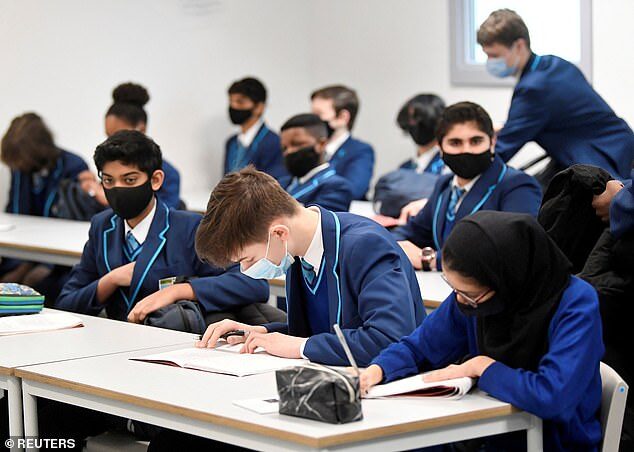
Just five per cent of pupils at one school agreed to take a lateral flow test at the start of the term and wear a mask, according to Damien McNulty, a national executive member of the National Association of Schoolmasters Union of Women Teachers (NASUWT).
"Sadly, we have had reports in the last 24 hours of at least six secondary schools in the north-west of England where children, in huge numbers, are refusing to take lateral flow tests or to wear masks," Mr McNulty told the BBC.
Comment: Back in July, some children were exposing the unfounded hysteria by using the lateral flow tests on orange juice in order to obtain a positive result and get some time off school.
"We've got one school in Lancashire where only 67 children out of 1,300 are prepared to have a lateral flow test and wear masks. This is a public health emergency."
It comes as new research published by the Department for Education (DfE) found that the majority of children say face masks in the classroom make it more difficult to communicate and learn.
The Government's official evidence summary found 80 per cent of pupils reported that wearing a face covering made it difficult to communicate, with 55 per cent feeling that wearing one made learning more difficult.
Comment: The British Journal of Sports Medicine reported that masks limit oxygen intake and lower performance. Forcing anyone to wear masks for any prolonged period of time is going to be deleterious, but particularly for children considering their developing physiology, and it the damage is causes may be irreparable.
The research noted that 94 per cent of headteachers said masks made communication between pupils and staff more difficult.
It highlighted a survey by the Unison trade union, which represents support staff such as classroom assistants and cleaners, which found 71 per cent of members said face coverings in secondary school lessons were an important safety measure.
The DfE study said masks are a "comparatively cheap and easy" measure to implement and can be a "visible outward signal of safety behaviour and a reminder of Covid-19 risks".
It includes the results of an "experimental" analysis of 123 schools by the department during the 2021 autumn term which found Covid absence fell by 0.6 percentage points in secondary schools that used face masks compared to schools that did not over a period of up to three weeks.
Researchers acknowledged that there was a "level of statistical uncertainty around the result", adding that it showed a "non-statistical and unknown clinical significant reduction in infection" with a risk of false positives 15 per cent of the time.
Earlier this week, Nadhim Zahawi, the Education Secretary, said the study suggested mask-wearing "made a difference" to transmission. But experts criticised the DfE's findings, saying there was "no statistical difference" in absence rates between the two groups of schools.
Prof Sarah Lewis, an expert in molecular epidemiology at the University of Bristol, said: "The study and research outlined in this report does not provide strong justification for introducing this policy in schools.
"The negative impacts of mask-wearing on communication and learning in schools are outlined in the report, and mask-wearing has an especially detrimental effect on those with hearing impairments who are excluded from class discussion. Where there is insufficient evidence of a benefit of a policy and evidence of harms, the default should be not to intervene."
Jamie Jenkins, a former head of health analysis at the Office for National Statistics, said: "For me, the findings of the report support not to put masks on children."
Meanwhile, a separate poll by the National Association of Headteachers found that half of school leaders are already using supply teachers to cover for absent staff. The survey of almost 2,000 members found that 37 per cent have been unable to get hold of supply staff.
More than a third of school leaders have had staff absence levels of over 10 per cent on their first day of term, the survey suggested.



Comment: It's perhaps revealing that, for the most part, it seems those that are invested in the hysteria - adults - are blinded to all the detrimental effects of mask-wearing, and they're also willing to overlook the complete absence of any evidence of their efficacy.
Note that it was less than 2 months ago that the UK's teaching groups held a restriction-free awards ceremony, whilst at the same time they were enforcing mask wearing on children and, as winter approached, some schools were following government advice that classes be held with windows open 'to allow for reasonable ventilation, without freezing'; unsurprisingly this brazen hypocrisy drew widespread condemnation from parents:
See also:
- 57% of Germans do not trust official Covid data, Health Minister admits numbers inaccurate
- Britain got it wrong, "Lockdowns aren't a public health policy", says UK's leading epidemiologist interviewed by The Guardian
- Another person sets themselves on FIRE in their car while screaming about Covid vaccine mandates in Australia
And check out SOTT radio's: NewsReal: New Year, Same 'New Normal': Mass Formation Psychosis & Crowd Psychology